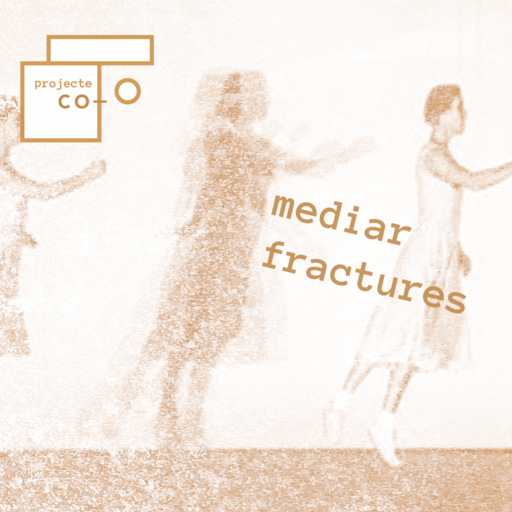
If you have any doubts, suggestions or collaboration: corpus@laescocesa.org
Mediating Ruptures.
A first approach towards the touch
Touching something or someone is where content emerges – touching the ground, touching the city, touching another person. An artwork’s potential lies not only in the object or in the concept; rather, it is located in the nature of the touch between object, people, and world.
Olafur Eliasson
"Contact" and "contagion" are two concepts that come from the same Latin root, cum ("together", "everything", "jointly") and tangere ("touching", "feeling", "grasping", "tasting" , "being with"). It seems as if the positive and negative values of both words remain united by the same thread in a gradation that varies between two opposite extremes, because when contagion occurs, the effect it generates immediately is precisely the opposite: avoiding contact.
As the social bodies that we are, our growth and survival depend on communication and cooperation with other bodies, in an affective interdependence that is vital. Disrupting this link between bodies can only lead to a loss of social contact, a state that can lead to health, emotional and psychological problems.
The current situation of Covid-19 in which we (un)live highlights the vulnerability of human interactions precisely through the way bodies are denied. Since the appearance of the virus and the declaration of the state of emergency, establishing physical contact with another body has become a "danger" and even a great social "threat". Touching, caressing, brushing, kissing, hugging, as well as all those actions that involve "being with" other bodies, remain in quarantine. And with this, our relationships, our social, emotional and psychological well-being, our immune system, our desires and even our precarious economies are also confined.
It is therefore necessary to claim the importance of the physical encounter between the bodies, exposing both their fissures and their limits and vulnerabilities. We are, above all, analogical and political bodies, places of production of knowledge and memory, of symbiosis and exchange, of social and ecological relations. In this function, bodies generate forms of literal and sensory expansion that make the systems and situations that are created outside the bodies also manifest internally. That is why it is essential to preserve and care for these biological functions that ensure their protection, as well as their immunological-affective stability.
Faced with this critical situation of bodies as a consequence of the health crisis, we believe that the response from culture should not be, as the only way, one of a generalized virtualization. It becomes necessary to overflow the screens that we inhabit digitally to explore other ways of accompanying each other that go beyond the virtual connection, where infinities of perceptions like smell, touch, taste and where the eyes are subjected to a short and focused vision disappear. With virtualization, the encounter with the unknown and the unforeseen also disappear.
For this reason, we think it is necessary to preserve and reconstruct this analog dimension of bodies, making visible the fragility and vulnerability of human relationships, building conditions of possibility of the sensible in the social space, and proposing reconnection strategies between bodies that produce potential contents as the fruit of other possible forms of interaction.
Culture needs bodies to be present again. And bodies also need culture to reconnect and to think of new ways of coexistence and to try them out. Art allows us to cross the border of the unthinkable and experience it as real, thus opening the range of possibilities. This gives it great potential to shift individual and collective subjectivities towards new, more resilient forms of coexistence. Therefore, a society better prepared to face changes needs culture and the interconnection of bodies (between bodies and with the ecological system that houses them).
In this sense, precisely the necessity that art must face is mediating between bodies. This mediation must consist both of making visible the problems posed by these fissures and of proposing positive ways of building relationships with other bodies. Art must be capable of mediating this great fracture rooted between the current denial of bodies (contagion) and the urgent need to "be with" them (contact)
Weaving, building relationships, creating proximity, caring, are in fact the mediating elements to rebuild our social interactions. In this sense, although there are certain mediating elements that produce our safety, such as the use of masks, gloves, and other prophylactic procedures, they also establish interaction barriers between the bodies and do not give rise to other possible forms of habitability, especially how they usually appear formulated in protocols.
Generating positive forms of encounter between bodies begins by enabling their expansion, their growth towards new paths of inter-habitability. We need to expand bodies more than ever, to germinate on plasticized sterile bodies, to give birth to life forms that make our security and subsistence viable.
In this role, art constitutes our extensible organ, a sensitive body that inspires, exhales, conspires (con-spirare: breathing together), that listens, that adapts, that survives. Undoubtedly, its transversal, and at the same time, inclusive capacity, allows the walls erected by fear and isolation to be eroded, affirming the body and the senses, enabling spaces for mutual understanding and empathy, creating new ways of inhabiting the world, where the bodies, while also being safe, are freer.

If you have any doubts, suggestions or collaboration: corpus@laescocesa.org